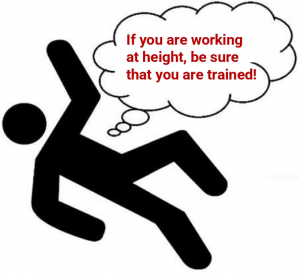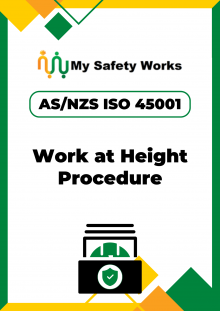Description
Working at Height Overview
To manage the risk of a person falling from one level to another, a safe system of work must be implemented for any work at height. Key systematic requirements include:
- The personnel assigned to work at height having the necessary training to conduct the work safely.
- Using the hierarchy of controls when considering methods for safe work at height to prevent major injury.
- The strict compliance with all applicable national codes, standards and legislative obligations.
- Ensuring the work is properly planned and supervised to protect against personal injury.
- The development of a rescue plan with all the required equipment and competent personnel available to enact the rescue plan.
Training in relation to the risks involved with working at heights must be provided to workers and can include instruction on work method statements, providing safe work procedures, safe sequencing of work, work at height permit systems and appropriate signage etc.
Note: If working in the construction industry where a person could fall more than two metres is a high-risk work activity and a SWMS must be developed for the work.
What is Working at Height?
Working at height refers to work where there is a risk to a worker’s health and safety associated with a fall from one level to another that is reasonably likely to cause injury to the person or any other person and could include:
- In or on an elevated workplace from which a person could fall.
- In the vicinity of an opening through which a person could fall.
- In the vicinity of an edge over which a person could fall.
- On a surface through which a person could fall.
- In any other place from which a person could fall.
Working at Height Hierarchy of Controls
Where the potential for a fall hazard exists, the highest reasonably practicable control to prevent a fall, and resulting in being liable to cause personal injury should be adopted.
The primary duty is to eliminate the risk, however, if this is not practicable, the risk must then be reduced to the minimum level. To do this, there is a preferred order (or hierarchy) of risk control measures, ranging from the most effective to the least effective.
There are five basic levels or rules to safely work at heights; these levels are aligned with the hierarchy of controls.
Level 1 Work at Height Controls
Examples of level 1 controls (elimination) include:
- Always try to bring the job to ground level so that there is no risk of falling.
- Pre-assemble as much as possible at ground level.
- Having suppliers provide loads that are pre-slung to avoid access to rigging activities at height.
If this is not possible look at level 2.
Level 2 Work at Height Controls
Examples of level 2 controls (passive fall prevention devices) include:
- A solid barrier or handrail so that the risk of a fall from height is eliminated.
- Ensuring that all edges of the work area are protected, reducing the risks.
- Using roof safety mesh to protect against fragile surfaces or a fragile roof.
- Using perimeter screens or mesh.
- Using temporary work platforms, i.e. scaffolds, elevating work platforms and work boxes etc.
If this is not possible look at level 3.
Level 3 Work at Height Controls
Examples of level 3 controls (work positioning systems) include:
- Using a travel restraint device or a harness with a static lanyard that will prevent you from reaching the unprotected edge and placing yourself in a position where a fall is possible.
- Using industrial rope access systems.
If this is not possible look at level 4.
Level 4 Work at Height Controls
Examples of level 4 controls (fall arrest harness type systems) include:
- Using a catch platform.
- Wearing and using a personal protective harness and lanyard with an energy absorber that is connected to a suitable anchor point.
- Personnel travelling from one location to another in elevated positions should utilize auxiliary fall protection equipment such as static lines, beam trolleys and anchors and inertia reels. Persons should always be ‘100% hooked up’.

If this is not possible, proceed to level 5.
Level 5 Work at Height Controls
Examples of level 5 controls include:
- Undertaking the work safely from ladders.
- Undertaking the work safely from trestles.
- Using administration controls for the work at height.
Note: The specific controls selected must eliminate or minimize the risk of falling as low as reasonably practicable in accordance with safety management systems requirements.
Contents of this AS/NZS ISO 45001 Work at Height Procedure
- Approval.
- Purpose.
- Scope.
- Terms and Definitions.
- Roles and Responsibilities.
- Procedures.
- General Height Safety.
- Working at Height Hierarchy of Controls.
- Working at Heights of Two Metres and Above.
- Fall Prevention.
- Edge Protection.
- Travel Restriction.
- Fall Arrest.
- Safety Harnesses.
- Equipment and Systems.
- Maintenance and Inspection.
- Unloading and Loading of Trucks.
- General Requirements for Working on Ladders.
- Single or Extension Ladders.
- Ladder Inspection and Maintenance.
- Stepladders.
- Falling Objects.
- Transferring Materials and Tools.
- Service Pits and Excavations.
- Scaffolding.
- Scaffold Inspection and Tagging.
- Mobile Scaffolding.
- Work at Heights Training.
- Work at Height Rescue.
- Related Procedures, Forms and Documents.
- Review Criteria.
- Record Management.
- References.
Why Choose to Buy this AS/NZS ISO 45001 Work at Height Procedure
- This 18-page work at height procedure can provide you with the guidance needed so that workers are not placed at risk when working at heights or where there is a risk of a fall by a worker from one level to another that is reasonably likely to cause injury. This includes working with plant, ladders, scaffolding and other activities that include a risk of falling.
- This procedure can be applied to all types of work at height and can help ensure workers conducting the work at height not endanger themselves, or other persons who may be exposed to falling objects.
After purchasing this AS/NZS ISO 45001 work at height procedure you will be able to:
- Very easily edit and customize the template to create your own work at height procedure.
- Apply your own style, format and brand to the procedure.
- Use it in any industry or sector regardless of the size or type of organization.
Availability and Use of this AS/NZS ISO 45001 Work at Height Procedure
- This work at height procedure is accessible to you right now by clicking the ‘Buy Now’ button.
- The procedure will be delivered to you in fully editable Microsoft Word format for immediate and full use in your business.
- There are no subscriptions, contracts or ongoing costs.

This AS/NZS ISO 45001 work at height procedure is 100% satisfaction guaranteed.
You may also require:


